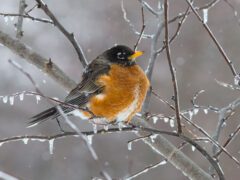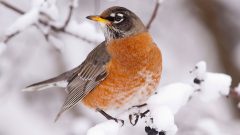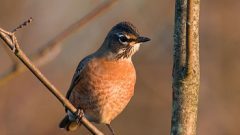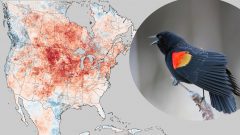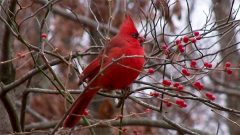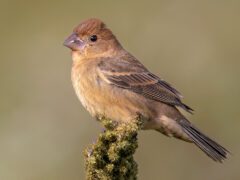American Robin Similar Species Comparison
Main SpeciesAmerican Robin
Adult male
Large round-bellied thrush. Males have a dark head, yellow bill, black streaks on the throat, and a rusty belly.
© Alex Eberts / Macaulay LibraryOhio, April 11, 2020Adult
Eats berries in the winter. Some individuals not easily separated by sex.
© Joshua Covill / Macaulay LibraryMontana, January 01, 2017Adult
Calls with a cuck or tuk to communicate with each other or a sharp yeep or peek as an alarm call. They also make a repeated chirr that rises in volume and can sound like a laugh or chuckle.
© DAVID BROWN / Macaulay LibraryNew York, May 01, 2004Adult (San Lucas)
The "San Lucas" American Robin, found only in Baja California Sur, is much paler than birds across the rest of American Robin's range.
© Dubi Shapiro / Macaulay LibraryBaja California Sur, June 26, 2017Female/immature male
Often seen tugging worms from yards.
© Ryan Schain / Macaulay LibraryMassachusetts, March 07, 2010Adult female
Females build the nest from the inside out, pressing dead grass and twigs into a cup shape using the wrist of one wing. Once the cup is formed, she reinforces the nest using soft mud gathered from worm castings to make a heavy, sturdy nest.
© Marie Read / Macaulay LibraryApril 14, 2010Female/immature male
Female/immature birds are paler than males and many birds in the West are paler than those in the East and Northwest.
© Shawn Loewen / Macaulay LibraryNew Mexico, March 11, 2017Female/immature male
Female/immature birds are paler than males with more white on the belly and throat.
© Mike Cameron / Macaulay LibraryTexas, November 25, 2020Adult
Runs on the ground with short rapid steps, pausing frequently to scan for prey and/or predators. Uses its bill to probe the ground and pull out earthworms.
© Eric Liner / Macaulay LibraryAlaska, June 21, 2007Juvenile
Juveniles have spotting on the back and chest.
© Marlene Kraml / Macaulay LibraryOntario, May 25, 2020Adult male
Chubby thrush with grayish back and darker tail.
© Ceredig Roberts / Macaulay LibraryIdaho, June 20, 2019Adult
Pulls earthworms out of the ground by using its strong legs.
© Timothy Barksdale / Macaulay LibraryArkansas, March 01, 2005Adult male
Builds nests of twigs and grasses held together with mud.
© Andrew Spencer / Macaulay LibraryOntario, May 18, 2014Adult male
Note orange underwing coverts in flight.
© Alex Lamoreaux / Macaulay LibraryNew Jersey, November 04, 2020Adult male
During the winter, often found feasting on berries.
© Glenn Perricone / Macaulay LibraryIllinois, March 22, 2014Similar SpeciesVaried Thrush
Adult male
Varied Thrushes of the Pacific Coast have an orange eyebrow, a black breastband, and orange wingbars that American Robins do not have.
© Nigel Voaden / Macaulay LibraryAlaska, June 05, 2015Similar SpeciesVaried Thrush
Female/immature
Female/immature Varied Thrushes have an orange eyebrow and wingbars unlike American Robins that do not have eyebrow marks or wingbars.
© John Reynolds / Macaulay LibraryBritish Columbia, December 18, 2015Similar SpeciesSpotted Towhee
Adult male
Spotted Towhees are smaller with a stouter bill than American Robins. They have a black hood that extends down to their breast with the rusty color restricted to their sides, unlike American Robins which have a reddish breast and a complete reddish belly.
© John Reynolds / Macaulay LibraryBritish Columbia, February 10, 2017Similar SpeciesEastern Towhee
Adult male
Eastern Towhees are smaller with a stouter bill than American Robins. They have a black hood that extends down to their breast with the rusty color restricted to their sides, unlike American Robins which have a reddish breast and a complete reddish belly.
© Davey Walters / Macaulay LibraryVirginia, April 20, 2016Compare with Similar Species
Click on an image to compare
Species in This Family
Thrushes and Allies(Order: Passeriformes, Family: Turdidae)
More to Read
Don't miss a thing! Join our email list
The Cornell Lab will send you updates about birds,
birding, and opportunities to help bird conservation.
















